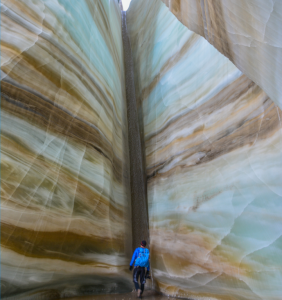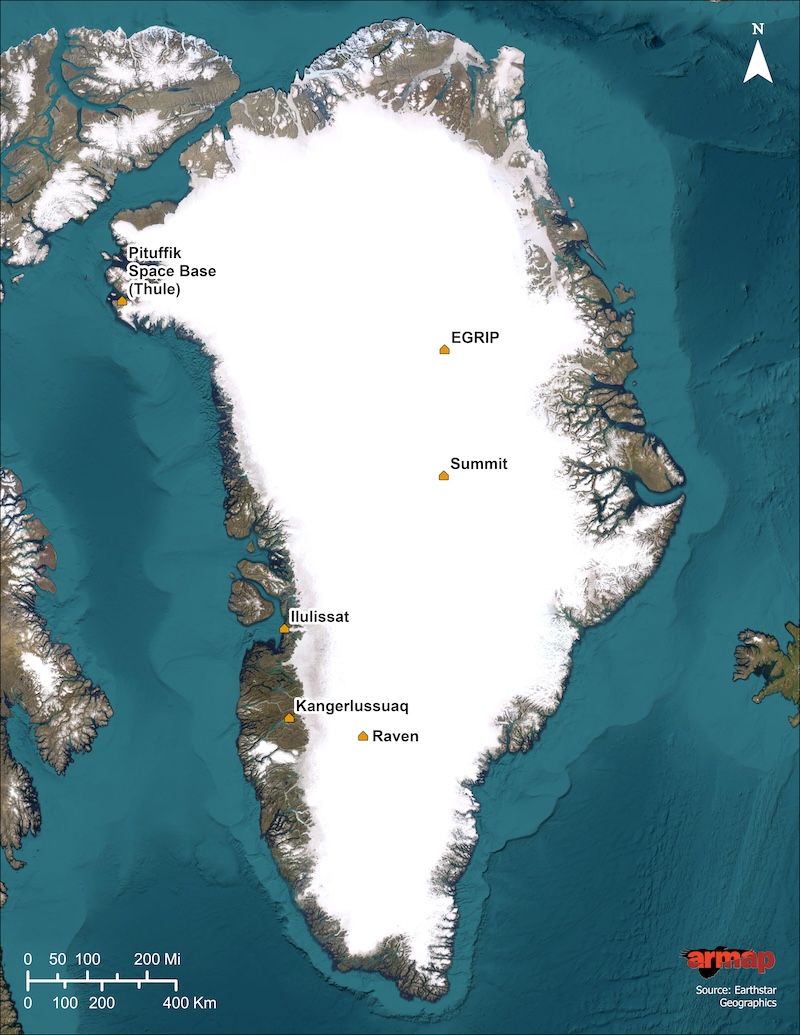
GREENLAND
Photo by: Robin Larocca
Greenland (Kalaallit Nunaat in Greenlandic) is the world’s largest island with three-quarters of the island covered by a permanent ice sheet. It is the least-populous land mass outside of Antarctica, with isolated population centers due to the absence of a connective road system. These factors, combined with the harsh environmental and seasonal conditions, make navigating the remote country logistically demanding. Executing field research in Greenland provides challenges due to travel distances, lack of infrastructure, limited resources, environmental risks, foreign permitting, custom regulations, language barriers, currency difference, and the requirement to coordinate with agencies ranging from the Government of Greenland (GoG) to Department of Defense (DoD) sections such as the Air National Guard (ANG) and the United States Air Force.
The Battelle ARO team provides support to researchers via acute knowledge of the environmental conditions, the limited transport options, political nuances, and the local challenges, which translates into thorough planning efforts and realistic scheduling for NSF funded field teams.
Discover more vital information in the Greenland Guide to help you plan your fieldwork in Greenland.

Photo by: Pat Smith
BATTELLE ARO HUBS IN greenland
KANGERLUSSUAQ
Kangerlussuaq (Formerly Sondestromfjord) this community is the base of Battelle ARO operations in Greenland. Located at 67° North, 50° 43′ West.
Kangerlussuaq Details
Kangerlussuaq serves as the destination for northbound Air National Guard flights serving the NSF’s Greenland research program, and is the starting point for most NSF-funded science projects working in Greenland. The Battelle ARO team staffs Kangerlussuaq during the summer months (typically March-September but flexible based on science requirements). Customer service is the main priority, and includes facilitating research logistics, engaging with the community, and supporting operational and construction projects.
Lodging is provided. All personnel are housed in the KISS facility. KISS has two-person dormitory rooms with common baths. Food also can be purchased at a local store and prepared in the KISS facility kitchens. Warehouses are where gear is stored and maintained, cargo services are performed, and storage for scientists exists (indoor, outdoor, and sample storage to –20° C).
SUMMIT STATION
At an elevation of 10,530 feet, Summit Station is located at 72° 36′ North, 38° 25′ West on the summit of the Greenland ice sheet.
Summit Station Details
Summit Station is one of the more unique research stations in the Arctic as its located at both high altitude and inland near the summit of the Greenland Ice Sheet. It supports a wide range of year-round research including clean air sampling, snow accumulation and property measurements, and maintaining cloud and atmospheric studies. During the summer, which runs mid-April to mid-August, campaign science groups and related activities can swell the population to a peak of 50; during the winter, a core staff of four to five maintain Summit’s experiments and facilities.
Through the staffing of science technicians, Battelle ARO can monitor and service science equipment, sample air and snow, reporting on project status, perform periodic calibrations, and support diagnostics and repairs so that PIs and researchers do not need to maintain a constant presence at the station.
Additional Summit Station resources:
EGRIP
The East Greenland Ice core Project (EGRIP) site is an international field camp 200 km from the ice divide.
EGRIP Details
The East Greenland Ice core Project (EGRIP) site is an international field camp 200 km from the ice divide. The project unites scientists from Greenland, Denmark, the United States, Germany, Norway, and Japan to characterize ice flow dynamics of the North East Greenland Ice Stream (NEGIS).
An international, Danish-led team of scientists are working at the EGRIP site to make borehole observations and harvest an ice core from a region with active NEGIS flow. NSF funded researchers may access the Danish-led team as the NSF supports the camp via coordination of Air National Guard flights and can thus negotiate quid pro quo support. Through this international collaboration, NSF funded researchers may gain access to work at the station itself or use it as a jumping off place to access remote areas of the ice sheet by either traverse or fixed wing air charters.
ILULISSAT
Ilulissat (formerly Jakobshaven) is a town in the Qaasuitsup municipality of western Greenland, about 350 km (220 miles) north of the Arctic Circle in Disko Bay.
Ilulissat Details
Ilulissat (formerly Jakobshaven) is a key place for Arctic research focused on sea level rise. Icebergs calve from Sermeq Kujalleq Glacier (also known as Jakobshavn Glacier) southeast of Ilulissat, at the inner end of the fjord. This glacier is the largest and most productive in the northern hemisphere, draining ice and meltwater from Greenland’s ice sheet into the Ilulissat Icefjord then west into the open ocean. Ilulissat Icefjord is a United Nations Educational, Scientific and Cultural Organization (UNESCO) World Heritage Site and the town has come to rely on tourism as its principal industry.
PITUFFIK SPACE BASE
Pituffik Space Base (formerly Thule Air Base) is located 900 miles South of the North Pole at 76° 32′ North, 68° 50′ West. Proper clearances must be obtained for accessing Pituffik.
Pituffik Space Base
Pituffik Space Base (formerly Thule Air Base) (PSB) is the United States Space Force’s (USSF) northernmost base and also has the northernmost deep-water port, making it a strategic place for military presence. Its placement also happens to be in an excellent location for research proposed in northern Greenland. The NSF utilizes a support agreement with the USSF and Battelle-ARO contracts with the base contractor to be able to use Pituffik as a hub for funded research in northern Greenland.
The Battelle-ARO team staffs Pituffik on an as-needed basis, determined by the level of science, operational, and construction projects planned each season. However, we leverage the expertise of off-site staff to successfully coordinate science support, logistics, and safety protocols by remote communications with our science project managers. Through this model Battelle ARO provides year-round support that includes access to lodging, lab space, truck allocations, air support charters, field equipment allocation, frozen sample storage, and more.
Additional Information: Pituffik Guide (must be logged in)
RAVEN CAMP
Skiway training facility for the New York Air National Guard 109th Air Wing – Located at 66° 29′ North, 46° 17′ West.
Raven Camp Details
Raven Camp is a seasonal installation that serves as a training facility for the New York Air National Guard (ANG) 109th Air Wing during Greenland’s summer months.
Raven Camp is staffed by two Battelle-ARO personnel seasonally (April-August) whose primary role is to maintain the skiway and provide communications to aircraft. Their presence is leveraged to support science projects in the vicinity of Raven Camp and has supported various snowmobile traverse platforms having launched from the site. Raven is beneficial for campaign science groups, as its location and skiway offers easy access for large cargo projects, and Raven does not have the emissions constraints (due to atmospheric science) to which Summit Station must adhere. Though staff are present to assist with ANG flight operations, the camp is not designed or staffed to provide the level of support that Summit Station does. Thus most groups who travel through Raven Camp must be prepared to be self-sufficient.
REMOTE GREENLAND
Remote research sites on the ice sheet, isolated villages, coastal tundra, and surrounding areas accessed by aircraft, foot, or traverse make up the majority of the funded research groups in Greenland.
Remote Greenland Details
Remote research sites on the ice sheet, isolated villages, coastal tundra, and surrounding areas accessed by aircraft, foot, or traverse make up the majority of the funded research groups in Greenland. Typically launching from a staffed hub, the Battelle ARO Team will provision and train researchers in camping, communication, NSF codes-of-conduct and harassment policy, and safety gear before they depart for their final science location.
Constant communication is facilitated by daily check-ins with the Kangerlussuaq office to ensure field parties are up to date on incoming weather, flight plans, and messages from home institutions. Support is customized for each research group’s needs, and Battelle ARO Team provide services could include remote travel, snow machines traverses, fuel caching, subcontracts for air support, and other needed support.

Photo from ARMAP

Planning Details
NSF and Battelle ARO provide the logistical support to get research teams and their equipment where it needs to be, when it needs to be there, even in the most remote locations.
The resources included here help ensure the coordination and work go as seamlessly as possible. Review each document thoroughly and reach out to your Science Project Manager for any assistance needed.
Resources
- Cargo Tracking System (CTS)
- Greenland Shipping, ANG Customs and Cargo
- Greenland Shipping, Commercial
- Scotia Park on Base, Personal Vehicle (must be logged in)
- Travel Advisory, ANG Scotia
- Travel Advisory, Commercial Copenhagen
- Uncrewed Aerial Systems in Greenland
Environmental Compliance
Securing permits for fieldwork can be challenging with long lead times. Although researchers are responsible for all permitting related to their fieldwork, the Battelle ARO team is available to assist and provide guidance throughout the permitting process. Battelle ARO can help identify required permits and provide expertise in specific areas that require local knowledge or other key agency contacts.
The Government of Greenland is currently overhauling their expedition permitting home page and guidelines. For the most up to date information, please refer to their permitting website. We will continue to edit this page as requirements are clarified or published.
Application Opening for 2026 Season Rescheduled to December 16, 2025
Science teams planning to work in Greenland must comply with all permitting requirements of the Government of Greenland and may include but is not limited to:
- Any overnighting expedition in the National Park
- Access to protected areas such as the Ilulissat Fjord or the UNESCO site outside of Kangerlussuaq
- Studies involving wildlife, or cultural heritage
- When leaving instruments in the field for more than 2 months
- When carrying a firearm for bear protection (and required if working within the National Park)
Researchers should include Greenland Home Rule permitting fee costs in the grant, currently approximate $800/year (based on 2026 4000DKK fee.) Projects working at Summit Station (or within Summit area allotment boundaries) may be included under the Summit group permit, acquired annually by Battelle ARO. Certain Summit area projects may be required to independently submit a sub-permit or additional applications.
If installing equipment within the Pituffik Space Force Base (formerly Thule Air Base) defense area, you must secure permission from the USSF command.
Resources:
